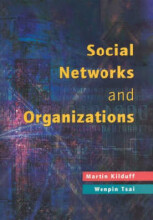Summary: Taking Stock Of Networks And Organizations: A Multilevel Perspective | Brass
- This + 400k other summaries
- A unique study and practice tool
- Never study anything twice again
- Get the grades you hope for
- 100% sure, 100% understanding
Read the summary and the most important questions on Taking Stock of Networks and Organizations: A Multilevel Perspective | Brass
-
1 Abstract and introduction
This is a preview. There are 2 more flashcards available for chapter 1
Show more cards here -
What is the central argument of network research?
That actors are embedded in networks of interconnected social relationships that offer opportunities for and constraints on behavior. -
What is Brass purpose with his research?
He reviews research on the antecedents and consequences of networks at the interpersonal, interunit and interorganizational level of analysis + evaluate recent theoretical/empirical trends +give directions for future research + highlighting the importance of investigating cross-level network phenomena. -
What is the purpose of the article of Brass?
To evaluate network research. And to take stock (balans) of the results of organizational network research at the interpersonal, interunit and interorg. levels of analysis, focusing on the antecedents (voorgangers?) and consequences of networks at each level. -
How does Brass define a network?
As a set of nodes and a set of ties representing some relationship or lack of relationship between the nodes.
-
What do Brass et al. mean with the interpersonal, interunit and interorganizational level of analysis?
These are relations among actors whether they are individuals, work units or organizations.
- Interpersonal: Individuals
- Interunit: Work units
- Interorganizational: Organizations
-
What can org. researchers explain through this network perspective? (4)
Traditional org. outcomes as:
1 Individual satisfaction
2 Performance and job exit
3 Group structure and performance
4 Org. innovation and survival -
2 Interpersonal networks
This is a preview. There are 2 more flashcards available for chapter 2
Show more cards here -
What are the antecedents of interpersonal networks?
- Actor similarity: Similar people tend to interact with each other. Similarity is thought to ease communication, increase the predictability of behavior and foster trust and reciprocity.
- Personality: Personality can affect social network patterns.
- Proximity and organizational structure: Formally differentiated positions locate individuals and groups in physical space and at particular points in an organizations' work flow and hierarchy of authority, thereby restricting their opportunity to interact with still others.
- Environmental factors: Mergers and acquisitions are environmental jolts that can substantially change network patterns within an organization.
-
What is the most important thing for network building? Proximity (nabijheid), actor similarity or personality?
Proximity. It is also likely that his facilitates initial contact, whereas email may help maintain relationships once they have formed. -
What is the link between environmental factors and networks? (Brass)
For ex. a change in an organisation, have a big impact on the social network. After a while this will restore to what it was before the change. Research discovered that national culture influence the social network patterns in organizations. -
3 The consequences of interpersonal networks
This is a preview. There are 8 more flashcards available for chapter 3
Show more cards here -
There are different consequences of interpersonal networks. What is meant with 'attitude similarity'?
People who interact become more similar. Change in attitude can occur primarily through social interaction. But also through copying attitude.
- Higher grades + faster learning
- Never study anything twice
- 100% sure, 100% understanding
































